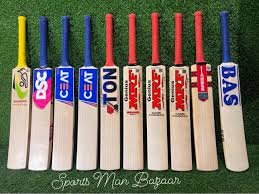India’s sports goods demands have been growing fast and steadily as a country expanding at an unmatched speed. Driven by a talented labour force hence recognised for its contribution to job creation and the national economy, the sector has prospered. About 500,000 people work in the sports goods manufacturing business in India and 60% of Indian athletic products are exported.
The existence of many established top cricket bat manufacturers in India makes the sports products sector very competitive worldwide. India has been a key participant in the athletic goods industry and has significantly increased its soft power, coming in third in Asia in manufacturing. India exports a range of athletic items including inflatable balls, general exercise equipment, cricket gear, apparel, and more to more than 200 nations, including the US, China, the UK, and Australia. Major multinational companies like Mitre, Umbro, and Wilson get their inflatable balls and other sports items from India. India was the second biggest manufacturer of bicycles worldwide in FY 22, and the export value of bicycles and associated components from India topped over $ 461 million.
By carrying out mega-sports infrastructure projects and supporting investments under the public-private partnership (PPP) model, the government hopes to turn India into a worldwide athletic superpower with a long-term influence on health, education, and tourism. The government has set up the Sports Goods Export Promotion Council (SGEPC) to support the manufacture of sports goods by boosting exports of Indian sports products. SGEPC often hosts both local and international trade fairs to provide Indian manufacturers a venue to display their goods and exposure to worldwide market trends. The Remission of Duties and Exported Products (RoDTEP) scheme and the Market Access Initiative (MAI) programme have been put in place to encourage Indian products and services export.
Assessing the Quality of Indian Sports Goods:
- Likewise, synthetic leather or rubber material footballs and volleyballs are well recognised for their longevity and water resistance. Over 90% of Indian manufacturers follow the most rigorous material criteria, which shows in the durability and dependability of the goods.
- To guarantee items satisfy such worldwide standards, Indian sports goods producers use rigorous quality control procedures.
- Design and Innovation Improving the performance and user comfort of sports items depends on design creativity. Indian manufacturers concentrate on ergonomic designs, spending around 15-20% of their yearly budget in R&D to promote innovation.
- Types and Choices From cricket bats, footballs, badminton rackets, to fitness equipment, accessories, and more, India has a whole spectrum of sports items. The choices are almost infinite, letting importers choose products that fit especially their market requirements.
- Testing and Quality Control There are many NABL (National Accreditation Board for Testing and Calibration Laboratories) certified laboratories in India. By means of thorough testing of sports goods for many criteria including durability, performance, safety, and environmental resistance, these laboratories guarantee only top-quality items reach the worldwide market. An SG cricket bat, for instance, undergoes over 50 separate quality inspections before being sent out.
- Sustainable Methods Sports items made under sustainable principles are in great demand as global environmental awareness grows. Indian producers are progressively embracing environmentally friendly policies such employing non-toxic products and reducing manufacturing waste.
Emphasising Distinct Selling Points:
Manufacturers and exporters may emphasise their own selling aspects by combining narrative, factual data, and consumer reviews. They may talk about the rigorous quality control policies they use, how traditional craftsmanship mixes with contemporary technology in the manufacture of sports products in India, and how world-famous sports figures have utilised these products. Engaging material on the company’s website, social media channels, and marketing materials may help to achieve this.
Encouraging Indian Sports Goods:
A major approach is working with overseas merchants and wholesalers. Participating in international sports expos, planning B2B meetings, or using digital media like LinkedIn and industry-specific online forums might help to achieve this. Retailers and distributors may be given reasonable rates, guaranteed quality, and on-time delivery.
Participating in global sports goods trade shows such as ISPO Munich, The Sports Show Minneapolis, and SportAccord will help one network with overseas importers, distributors, and retailers. Online networking tools like as Meetup and Eventbrite may help you locate and participate in sports goods sector networking events.
Exporting Details of Packaging:
Sports goods export depends much on packaging. It guarantees the item gets to the buyer in ideal shape and without any harm.
- Materials are selected according on their strength, price, and degree of protection they provide.
- Adequate padding and cushioning are given within the box to avoid any damage during delivery. For fragile goods like badminton rackets and tennis balls, this is especially vital.
- Once the items are packaged, the box is sealed to stop any tampering. The package is labelled appropriately upon sealing. These labels include export-related information as well as product and handling advice.
- manufacturing Process: Quality is ensured at every step of the manufacturing process for sports products, which consists of several phases each needing close attention. This covers:
- Choosing Raw Material: The first stage is choosing the appropriate raw material, which will help to define the quality and performance of the product.
- The raw ingredients are subsequently processed to create different components of the sports product. For instance, the blade of a cricket bat is made by cutting, shaping, and processing the willow.
- The treated components are then put together to create the finished product. Sometimes this calls for hand labour; other times machines are used.
- Quality Control: After assembly, the product goes through many quality inspections. This covers performance testing, specification compliance verification, and defect detection.
- The last stage is packing the item and getting it ready for shipping. This calls for ensuring the packing is strong and durable and that the item is wrapped so that it won’t suffer harm during transportation.
Conclusion
Though a great top Meerut bat factory, China sometimes gets flak for the quality of its products and lack of personalisation. Though good in certain areas, Pakistan lacks the variety India provides.


